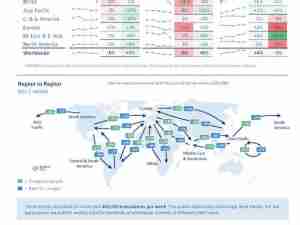Boeing Co.’s top executive is growing confident the company can soon restore its commercial standing in China, while cautioning about a rocky path ahead as the two superpowers joust over trade and politics.
The US manufacturer is working to restart deliveries of the 737 Max, its top source of revenue, in China after a four-year halt. Over that hiatus, arch-rival Airbus SE grabbed the lead in a market that had traditionally been split evenly between the two manufacturers. China’s home-grown planemaker, Comac, has meanwhile gained a foothold with its recently launched C919 jet.
Comac will likely evolve into a global player, but the market is large enough to support all three, Chief Executive Officer Dave Calhoun told reporters in a briefing on May 30, pointing out that Boeing has worked with China for 50 years.
“We continue to support them as they get their Maxes back in the air,” the CEO said. “And I expect things will move forward in a more constructive fashion with fits and starts in the political environment today.”

Reviving sales in China, the world’s second-largest aviation market after the US, is just one issue confronting Calhoun, who must also grapple with product strategy while repairing Boeing’s balance sheet. In his first press conference since early 2020, the CEO assessed competitive threats and the topsy-turvy market spurring airlines to lock in deliveries into the next decade. He also explained why he thinks Boeing can wait a decade to introduce its next all-new plane.
Rising Tempo
Weathering supplier disruptions and regulatory delays are a bigger concern for Boeing than clawing back market share from Airbus, Calhoun said. The Toulouse, France-based planemaker is poised to dominate the all-important narrowbody market this decade, aided by its coming A321XLR, a mid-sized jet for which Boeing has no directly competing product.
“I don’t want to suggest that we can’t do it, because I think we can,” Calhoun said of regaining market share. He attributed the lost ground that has given Airbus about 60% of the single-aisle market to a “hangover from not being able to deliver airplanes” during the 737 Max’s grounding following two fatal crashes, and Boeing’s gradual factory restart.
For now, Calhoun is focused on returning work in Boeing’s factories to a stable, steadily rising tempo and getting the next aircraft models the company is developing — the 737-7, 737-10, 777-9 and the 777-8F air cargo hauler — through Federal Aviation Administration certification. Senior Vice President Mike Fleming said Wednesday that certification of the 737 Max 10 could slip into 2024.
787 Ramp-Up
As Calhoun spoke, workers in the 787 factory behind him poured concrete for a second final assembly line to replace manufacturing that Boeing shuttered in 2021 as Covid decimated the market for long-range aircraft.
These days demand is soaring. Boeing has raised 787 output to a four-jet monthly rate in the North Charleston, South Carolina, plant, and aims to produce five of the wide-body jets a month by year-end. The second line will double output to 10 a month by early 2025. Workers have already been hired and are helping repair jets with tiny structural defects. That issue, which largely halted 787 deliveries for nearly two years, compounded Boeing’s early-2020s financial woes.
Calhoun downplayed the competitive threat to Boeing’s biggest cash cow, the 737 Max 8, from a comparably sized model being studied by Airbus. The prospect of a larger version of Airbus’s A220 single-aisle is generating speculation ahead of the Paris Air Show this month.
“I can’t call out any strategies on the other side, but I’m not particularly worried about the -8,” Calhoun said.
Boeing calculates that savings from operating aircraft within the same family will trump some of the benefits offered by the A220’s newer design, Darren Hulst, a Boeing marketing executive, told reporters at the South Carolina event. The A220 starts at around 100 seats and would top out with the proposed 170-seat A220-500.
New Jet
With both Boeing and Airbus targeting a clean-sheet aircraft by around 2035, Calhoun is skeptical whether either manufacturer would want to invest in an “incremental” airplane in the interim — a reference both to the mid-market model he scrapped at Boeing and the potential A220-500.
Boeing is testing some new technologies for a jet that may eventually replace the 737 next decade, including an ultra-long wing supported by trusses that it’s been refining with NASA.
To support the investment, new airplane development programs “have to be 50, 80, 100-year programs. They can’t be 20 years,” Calhoun said.






